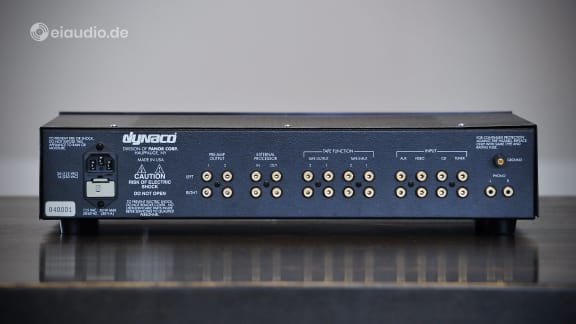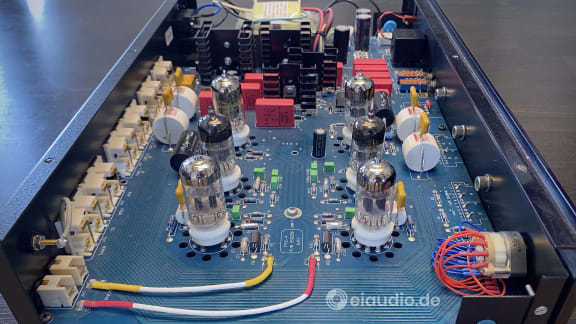Dynaco PAS-4
Published: 06/06/2021
Manufacturing date: 1993
Author: Karsten Hein
Category: Gear & Review
Tag(s): Pre-Amplifiers
In audiophile circles, the name Dynaco is reminiscent of the famous budget assembly kits that would hold up against some of the most exquisit audio products on the HiFi market during the 1960s and 70s. Originally founded by David Hafler and Ed Laurent in Philadelphia in 1955, the company’s first products were the 50 and 60 watts mono amplifiers Dynaco Mark II and III and the preamplifier PAM-1. But it was not until the launch of the Dynaco ST-70, a 2x35 watts tube amplifier design in 1959 that the company made its entry to the audiophile mass market.
Dynaco went on to manufacture other tube and solid state amplifiers, preamplifiers, radio tuners, and bookshelf speakers. Their most powerful amplifier was the solid state Dynaco ST-400 which was launched in 1972 and offered 2x200 watts of continuous output power with sophisticated speaker protection. By this time, the formerly independent Dynaco had already become a subsidiary of Tyco, Inc. with David Hafler still active until 1974, when he finally left the company to join Ortofon in 1974 and then went on to start his own Hafler Company in 1977.
The original Dynaco was liquidated in 1980 and lay dormant until the Pan Orient Corporation acquired the trademark in 1993 and began marketing audio components under the Dynaco brand. Pan Orient soon shortened its name to ‘Panor’ and began launching updated versions of Dynaco classics as well as some new designs. Among these were the ST-70 successor ‘Stereo 70 II’ and the more powerful ‘Stereo 160’, a 2x70 watts all-tube power amplifier that was packed with audiophile features, such as switchable pentode/triode modes and adjustable tube bias.
When it comes to the Dynaco PAS-4, vintage audio fans will be quick to point out that this preamplifier design is a Dynaco in name only, because it was produced and sold by Panor during the early 90s. However, the Dynaco brand name was not chosen without reason, as Panor was serious about improving the original Dynaco/Hafler designs and was set on once again producing affordable audiophile gear for the average consumer with a medium-sized budget. Visible proof of this mission are the PAS-4’s no-frills industrial cabinet and design choices, as well as its selection of audiophile components.
The PAS-4 was developed under the direction of John Nunez, a former developer with the high-priced tube equipment specialist Moore Franklin Associates (MFA). John knew that, if he wanted to convince audiophile consumers of the PAS-4’s merits, he needed to get vinyl reproduction right. He therefore took good care to make the phono stage of the PAS-4 outstanding. Manufacturing quality was also intended to be excellent, with all units sold being designed and manufactured in the USA. Sadly, however, Panor had to make some concessions to meet the relatively low price point which hindered some of the PAS-4’s audiophile potential and frustrated some of the early customers.
Despite its outstanding design, the PAS-4 was sold fitted with the cheapest tubes available and came equipped with switches that were given to fail. It also offered additional circuits for improved usability that were not in keeping with the audiophile tradition of reducing the circuitry to the bare essentials. The first customer reviews of the new preamplifier reflected these shortcomings, and resulted in only a few thousand units of the PAS-4 being sold, thus making it a rare find on today’s vintage market.
The unit shown here is a completely different beast from the version sold by Panor. It is closer to the original audiophile design and includes most of the recommended updates and modifications that have been found beneficial over the nearly three decades of its existence. Of course, it helped that the original basis was excellent: 1/8” thick circuit boards, high quality tube sockets, excellent trace layout with star grounding, and each tube with its own voltage regulator. Changes and updates to our PAS-4 include changing to an improved hum-free 230V transformer, adding a high-quality rotary Elma switch for source selection, bypassing the tape monitor and tape dubbing circuitry, eliminating the channel balance attenuator, and bringing in an audiophile grade Noble volume attenuator.
The original tubes were replaced with Russian Tung-Sol 12AX7 SC803S and SOVTEK type 6922 for the 2-stage phono section, as well as a pair of Genalex 20 03 for the hybrid line stage. The capacitors were updated to Mundorf Supreme EVO Silver Gold Oil. The aim of the updates was to minimise internal and external noise and distortion and to increase transparency, responsiveness, and dynamics. Configured in this way, the PAS-4 becomes a worthy audiophile contender in true Dynaco tradition. And, while the original preamp cost around 1,000 dollars new, following these updates, it can easily compete with preamplifiers costing 2-3 times this amount. Hafler trusted in the craftsmanship of the DIY home builder, and, apparently, so did Panor. While it took some expertise to unravel the PAS-4’s genuine character and potential, the good news is that it was possible by simply building on the superb infrastructure that was already present.
Setting up the PAS-4 in our household for the first time, I noticed that tube gear is a little more difficult to set up than solitary state equipment. My preference was to fit the PAS-4 in our main system where it was to replace our DB1 preamplifier and to play with our B&K ST-140 amplifier into Martin Logan electrostatic speakers. In this position, however, the PAS-4 was lacking the upper frequency band in a way that most of the transients were lost and that the music sounded stale. It sounded as if the tubes had reached the end of their life expectancy, or as if there was some other major problem with this preamplifier. After 2 days of trying different cable combinations I gave up and took the PAS-4 to our other system.
In its new position, the PAS-4 was to replace our Restek V1 preamp and to play with our Hafler XL-280 amp into Tannoy XT8F speakers. Here it immediately showed that the Panor/Dynaco is a Hafler derivative. The PAS-4 pre and Hafler XL-280 amp turned out to be a match made in heaven. In retrospect, this is perhaps not surprising, given the PAS-4’s pedigree, but to me it came as a revelation at the time. I simply could not understand how the same preamplifier could perform so differently in combination with two amps that it sounded broken in the one position and absolutely brilliant in the other. For the first time, the Tannoys’s sonic character also matched their physical appearance. The XT8F are not exactly small speakers, but somehow the Restek V1 in combination with the Hafler had made them sound overly precise and academic, instead of musical and dynamic.
The PAS-4 is able to build a huge stage from left to right that extends far beyond the speakers. Instruments position themselves freely with plenty of dark spaces around them. I have found that treble highlights are fewer than in combination with the Restek V1 but more pronounced when they occur. Transients are fully present and sounds linger in realistic fashion. Similar to most tube equipment, the PAS-4 can introduce interference, which will result in humming or hissing when something is not right in the setup. In my first attempt to pair it with our Hafler amp, I had not noticed that its power cord was touching that of the Hafler amp. This resulted in audible hissing on both amp channels. In fact, noise was a complaint that I had also read in some owner reviews. When everything is set up properly, however, the PAS-4 is nearly as silent as the Restek V1. One would have to hold the ear directly to the tweeter section of the speakers to hear the remaining noise.
As is the case with most serious HiFi gear, the PAS-4 will reveal the difference between a standard power cord and one that has been designed specifically for use in audio applications. On our own system, we have paired the PAS-4 with a Lapp Ölflex 2,5mm fitted with ferrite clamp to good result, but I suspect that one could get even better performance from this preamp with a more sophisticated cord. The difference between the standard cord and the Lapp cable was so striking that I suspect that further improvements in this position will again have a major impact.
After switching on, the PAS-4 needs about 15 minutes for the tubes to warm up. Actually, it will already play music after 45 seconds, but sound stage and dynamics do need some time to develop. Transients only sound right after some 30-40 minutes of playing. At this time, the six tubes will have reached their full operating temperature—which is actually quite hot. The slim cabinet design means that the tubes are literally touching the top of the enclosure, and I have meanwhile read that many users are leaving the lid off completely to improve ventilation. My reasons for leaving the cover on despite this are the presence of children in the household and the belief that the enclosure functions as a Pharadeic cage to protect the inner circuits from outside interference.
The PAS-4 puts out lots of power, with normal listening volumes being present at around 9 o’clock on the volume dial. Since the same is true for our DB1 and V1 preamplifiers, I suspect that this is a general tendency with audiophile grade preamplifiers. In contrast to our solid state gear, the PAS-4 strikes a more soothing balance between treble and bass notes without sacrificing transparency. Voices sound fuller and richer, double bass and lower piano notes have a greater sense of dimension and authority to them. To my ears, the PAS-4 puts out a more satisfying and realistic bass performance without the aid of a subwoofer in our system. Our Tannoys surely benefit from this and are sounding even more engaging. It is therefore not surprising to me that the PAS-4 is awarded 4.8 out of 5 stars in audioreview. For us as well, this unpretentious looking preamp is a definite keeper. If you can get your hands on a specimen in good condition and find yourself in a position to have the basic modifications done: do it. Where it fits in, the PAS-4 is going to be very hard to beat at this price point.
Specifications
Phono
- Gain: 40 dB
- RIAA accuracy: +/-0.5 dB (20 Hz-20,000 Hz)
- THD: <0,025% (@2V RMS output)
- Input impedance: 47k (shunted by 10 pF)
- Signal to noise ratio: -86dB (<10mV RMS input)
- Absolute phase: non-inverting
- Tube complement: 2ae 6DJ8/6922; 2ae 12AX7/ECC83
Line
- Gain: 18,5 dB
- Frequency response: 2 Hz-150,000 Hz (-3 dB)
- THD: <0,025% (@2V RMS output)
- Input impedance: 25k (nominal, all inputs)
- Output impedance: 40 Ohms
- Signal to noise ratio: -90dB (<10mV RMS output)
- Absolute phase: inverting
- Slew rate: 40 volts per uS
- Tube complement: 2ae 6DJ8/6922
Physical
- Power consumption: 45 Watts
- Dimensions: (W) 43.18cm x (H) 9.52cm x (D) 30.48cm
- Weight: 5,44 kg
- Country of manufacture: China
- Year: 1993





